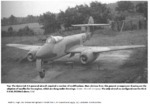Sometimes contemporary turbines use centrifugal in series with axial compressors, but always put the centrifugal after the axial as it's more effective at the high pressure end. On the other hand, as you say, the centrifugal gave "combat ruggedness and the ability to ingest turbulent air." In a combat situation, straightforward technical considerations may be less important than resistance to damage from flying shrapnel or other loose battlefield material. The Russians have taken that very seriously, see Foreign object damage - Wikipedia
"...The Russian Mikoyan MiG-29 and Sukhoi Su-27 fighters have a special intake design to prevent the ingestion of FOD during take-off from rough airfields. The main air intakes could be closed with mesh doors and special inlets on the top of the intakes temporarily opened. This would allow enough airflow to the engine for take-off but reduced the chances of the engine sucking up objects from the ground..."
Just a note as to why the first Whittle Engines had such a large diameter. Whittle was very concerned by shaft alignment and vibration and wanted the turbine disk and shaft fabricated in one piece. He was a very good engineer. Therefore he used double reverse flow combustion chambers to keep the distance between turbine and compressor short. This was the one idea von Ohain copied from Whititles patent thought he used an annular reverse flow combustion chamber for the HeS 003. When Rolls Royce became involved they got rid of the reverse flow feature to reduced the engine diameter and used their resources to ensure there was no shaft alignment issue.
The diameter issues disappeared by making outsized engine nacelles, as engines became more compact overall and of course the Americans fixed it by just putting a big engine inside the P80. In a way deHaviland did the same with the Vampire/Goblin.
In some photographs (Anthony Kay's book) has a photograph of a sort of bird cage basket over Jumo 004 engined intakes. These were to protect ground crew but it was found that flight was uneffected and combat missions were conducted with no effect on performance with the baskets on. They were flown in combat to protect against combat FOD. All up the Jumo handled intake disturbance better than they expected. Kay's book has a photo of a Jumo 004 with a 10ft stove pipe intake extension to simulate an air intake duct for the Messerschmitt P1011. It worked well with only 3% loss in thrust.
Last edited:


